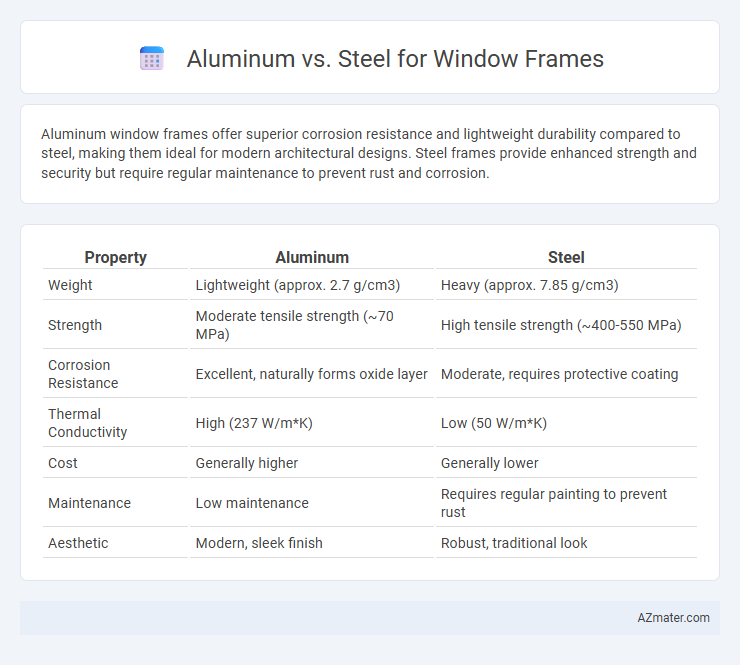Aluminum window frames offer superior corrosion resistance and lightweight durability compared to steel, making them ideal for modern architectural designs. Steel frames provide enhanced strength and security but require regular maintenance to prevent rust and corrosion.
Table of Comparison
| Property | Aluminum | Steel |
|---|---|---|
| Weight | Lightweight (approx. 2.7 g/cm3) | Heavy (approx. 7.85 g/cm3) |
| Strength | Moderate tensile strength (~70 MPa) | High tensile strength (~400-550 MPa) |
| Corrosion Resistance | Excellent, naturally forms oxide layer | Moderate, requires protective coating |
| Thermal Conductivity | High (237 W/m*K) | Low (50 W/m*K) |
| Cost | Generally higher | Generally lower |
| Maintenance | Low maintenance | Requires regular painting to prevent rust |
| Aesthetic | Modern, sleek finish | Robust, traditional look |
Introduction to Aluminum and Steel Window Frames
Aluminum window frames offer lightweight durability and resistance to corrosion, making them ideal for modern architectural designs and coastal environments. Steel window frames provide exceptional strength and security, often used in industrial or historic buildings for their robust structural support. Both materials require minimal maintenance but differ significantly in thermal performance and aesthetic appeal, influencing the choice based on climate and design preferences.
Material Composition and Properties
Aluminum window frames are composed primarily of aluminum alloy, offering lightweight strength and excellent corrosion resistance due to a natural oxide layer, making them suitable for humid environments. Steel window frames consist mainly of carbon steel or galvanized steel, providing superior structural strength and durability but requiring protective coatings to prevent rust and corrosion. The thermal conductivity of aluminum is higher than steel, which may impact energy efficiency unless thermal breaks are incorporated into the frame design.
Strength and Durability Comparison
Aluminum window frames offer excellent strength-to-weight ratio, ensuring robust support while remaining lightweight and resistant to warping or cracking. Steel window frames exhibit superior ultimate strength and impact resistance, making them ideal for high-security applications, but are prone to corrosion without proper treatment. Both materials provide durable options, with aluminum excelling in low-maintenance longevity and steel offering enhanced structural integrity under extreme stress.
Thermal Insulation and Energy Efficiency
Aluminum window frames have higher thermal conductivity, leading to increased heat transfer and reduced energy efficiency compared to steel frames with thermal breaks. Steel frames offer better thermal insulation due to their lower thermal conductivity, helping maintain indoor temperatures and reduce heating and cooling costs. Modern steel frames often incorporate thermal barriers, enhancing energy efficiency by minimizing thermal bridging in building envelopes.
Maintenance and Longevity
Aluminum window frames require minimal maintenance due to their resistance to rust and corrosion, making them ideal for humid or coastal environments. Steel frames offer superior strength and durability but demand regular upkeep such as repainting and rust prevention treatments to extend their lifespan. Over time, aluminum frames typically outlast steel by resisting environmental wear without extensive maintenance efforts.
Aesthetic Versatility and Design Options
Aluminum window frames offer superior aesthetic versatility with sleek, modern profiles that can be easily customized in various colors and finishes to complement contemporary architectural styles. Steel frames provide a robust, timeless look with thinner sightlines, allowing for larger glass panes and more intricate design possibilities in industrial or classic settings. Both materials support diverse design options, but aluminum excels in lightweight, corrosion-resistant finishes, while steel ensures strength for expansive, elegant window designs.
Cost Analysis: Aluminum vs Steel
Aluminum window frames typically cost less upfront compared to steel, offering a more budget-friendly option for residential projects. Steel frames, while initially more expensive, provide superior strength and durability, potentially lowering long-term maintenance and replacement costs. Considering lifecycle expenses, aluminum may incur higher upkeep due to corrosion in harsh environments, whereas steel's robustness can result in greater cost efficiency over time despite higher initial investment.
Environmental Impact and Sustainability
Aluminum window frames offer high recyclability and require less frequent replacement due to their corrosion resistance, reducing overall resource consumption. Steel frames, despite their strength, have higher embodied energy and emissions during production but benefit from widespread recycling infrastructure, minimizing landfill waste. Choosing aluminum or steel impacts sustainability depending on factors like production processes, lifespan, and end-of-life recyclability.
Security and Safety Considerations
Aluminum window frames offer strong resistance to corrosion and require less maintenance, but steel frames provide superior strength, making them more effective at withstanding forced entry and enhancing overall security. Steel's higher tensile strength and rigidity contribute to better impact resistance, crucial for safety in high-risk or vulnerable areas. Both materials can be combined with advanced locking systems and reinforced glass to optimize security and safety in residential and commercial applications.
Choosing the Right Material for Your Window Frames
Aluminum window frames offer lightweight durability and excellent resistance to corrosion, making them ideal for modern, low-maintenance designs in coastal or humid environments. Steel frames provide superior strength and security, suited for industrial or traditional styles where structural integrity and impact resistance are priorities. Consider factors such as thermal conductivity, maintenance requirements, aesthetic preferences, and budget to choose the optimal material for your window frames.

Infographic: Aluminum vs Steel for Window Frame
 azmater.com
azmater.com